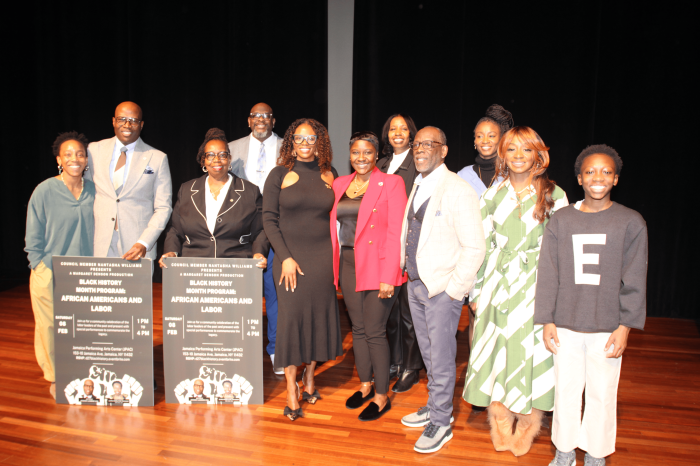BY ALBERT AMATEAU | When did it start? Age 3 going on 4, stomping through a half-empty house, shouting, “Where’s my printing set?” Gave explicit instructions to mother and father not to forget it in the move from Kings Highway, Brooklyn to Utopia Parkway, Queens. Don’t remember finding it.
Copy boy, World Telegram & Sun (125 Barclay St., 1952?). Made friends with fellow copy boy a few years older who lived on Avenue A, Allen Ginsberg. He carried around a library book about the Mayans and said he was going to Yucatan to see the ruins, then hang out with friends in San Francisco.
Ginsberg tells me about visiting Ezra Pound at St. Elizabeth’s asylum in Washington, D.C. Shows me a type- script of his own poems with a short blurb by William Carlos Williams. I show him a poem I had written with some not-very-good rhymes. His cri- tique: “Forget that tired crap.”
MORE ON THE RETIREMENT OF THE “DEAN OF COMMUNITY JOURNALISM”
Copy boy on New York Post (75 West St., 1956?), working midnight-to-8 a.m. shift: July 25, 1956, city room fran- tic. Andrea Doria bound for New York collides off Nantucket with outbound Swedish-American liner Stockholm.
“[Post publisher] Dorothy Schiff’s grandson and ex-daughter-in-law, [film actress] Ruth Roman are aboard. Look for them. Take a copy boy with you,” says night city editor to man on rewrite desk, who takes me.
We do not find Ruth Roman. She lands the next day, rescued by the Ile de France. Her son, Richard Hall, 3, arrives July 27 aboard the Stockholm, which came in under her own power.
Andrea Doria capsized and sank, 1,660 rescued, about 50 were lost, including five or six Stockholm crew.
Receive free press ticket to “Waiting for Godot,” first Broadway production, with Burt Lahr and E.G. Marshall. Still remember that bleak, funny, compelling performance.
Lafayette, Louisiana. Daily Advertiser, 1956, first job as a staff reporter. South Louisiana, many country people speak Cajun French. Politics divided between Long and Anti-Long. (Earl Long, Last of the Red Hot Poppas and Huey’s brother, is governor.) Beat includes City Hall, police, fire. Later, I’m editor of real estate and oil-exploration pages, know- ing nothing about either.
“You ever smoke marijuana?” asks Police Chief Carlo P. Listi, who invites me in, introduces me to a couple of narcotics agents from Houston. Funny smell in the police station. Gives me a skinny cigarette and lights me up.
“You got to hold it in a little bit,” instructs a very relaxed agent.
“How do you like it?” asks Listi.
I shrug, “O.K.”
Agent looks at me with pity, says, “Don’t know how to smoke weed, eh?” Lafayette was second stop on their “Beware the Weed” tour, with 90 miles still to go before New Orleans.
Yet another day, publisher calls me upstairs about lawsuit for a million dol- lars filed by white plaintiff against Daily Advertiser naming me for “impugning his honor as a Southern gentleman” in a police item about a brawl over “a colored girl.” Suit soon dismissed.
Beat includes weekly Rotary Club lunch where Tennessee Governor Frank Clement appears — one of several stops he makes across the South in 1957 — to justify calling state National Guard to quell riot following integration of Clinton, Tenn., Central High School. File story at Western Union office to AP regional desk.
June 25, 1957, Hurricane Audrey makes landfall with 140 mile-per-hour wind and 15-foot storm surge in Vermillion Parish, just south of Lafayette. Next morning, edi- tor sends me with Speed Graphic camera to fly over the area in three-seat, single-en- gine plane. When pilot banks, I point cam- era out of window and shoot. Surprised at good photos of devastation. First estimate: 200 deaths. Editor makes me lowball it down to 40. Deaths eventually total 400 in Vermillion and Cameron parishes.
Syracuse Post Standard’s North Country bureaus in Ogdensburg and Watertown, 1959, record cold and snow. St. Lawrence River ice stops ferry service between Ogdensburg, N.Y., and Prescott, Ontario. State editor assigns me to inquire about possibility of cars crossing the river on tops of St. Lawrence Seaway dams. Seaway Authority chief Robert Moses does not return phone call.
Ogdensburg Bureau includes state court in Canton, N.Y. Cover “deer-jacking” cases against defendants hunting at night and shining flashlights in deers’ eyes.
Watertown Bureau: John Foster Dulles, U.S. secretary of state, January 1953 to April 1959, dies in May 1959. State editor assigns me the obituary because Dulles grew up in Watertown and used to sail from nearby Henderson Harbor Yacht Club on the east end of Lake Ontario. Obituary made Post Standard front page, all editions.
Assigned to cover Queen Elizabeth II during 1959 visit to Kingston, Ont. Took photos with Speed Graphic. Not very good.
Knowing nothing about millinery, hired by Millinery Research in 1961 as editor of 12-to-16-page trade weekly with office in center of budget millinery district, West 39th Street between Fifth and Sixth Avenues. Interview Alex Rose, head of Hat, Cap, Millinery Workers’ Union and influential co-founder of Liberal Party. He scolds me for not wearing a hat.
Included occasional items on Emile Griffith, up-and-coming welterweight boxer with day job in stock room of a Sixth Avenue millinery house. Items get longer as Griffith’s boxing star ascended. Covered fight in St. Nicholas Arena (West 66th Street at Columbus Avenue, now ABC tele- vision studio), where an unpopular decision gives Griffith the win, provoking peeved fans to fling folding chairs down from the balcony.
“This is a millinery paper, not a sports sheet,” says the publisher, putting an end to boxing stories.
One day a week at the printer, Peña Press, West 28th or 29th Street under the High Line. In addition to Millinery Research, they print Taxi Weekly; La Farandula, weekly Spanish entertainment magazine; and Al Islah, Arabic-language weekly paper writ- ten, typeset and published by Dr. Charise, a priest of the Maronite Rite of the Catholic Church, with an Arabic-speaking Lebanese congregation.
Peña Press, on the second floor, had an Arabic linotype machine on which the good doctor composed his articles and set them in type at the same time.
A Hungarian-language paper also published there, but I never met anyone con- nected with it. Downstairs, Japanese weekly Hokkaido Shimbun published. Shimbun printers set type by hand and would occasionally came up to Peña Press, use a piece of equipment, then run back downstairs. It was an incredible establishment.
Fairchild publications, Women’s Wear Daily, other daily and weekly trade papers, 1962-65, covering state and federal courts from courthouse pressrooms. State Supreme Court had two pressrooms because of bitter feud between Daily News and Post reporters. Plaintiffs, defendants, lawyers and judges who wanted ink would occasionally drop in.
Actor Zero Mostel walks in with a cane, talks about his personal-injury case. Roy Cohn, with several law partners, also comes in. So does Prince Felix Yusupov, said to be leader of aristocratic gang that in December 1916 assassinated Rasputin, monk with powerful influence over the Tsar’s family. The prince was suing a writer for questioning his role in the Rasputin assassination.
Dr. Charise, my friend from Peña Press, comes in one day to talk about a church dispute that found its way to state Supreme Court. Assigned to federal court, where pressroom radio is always tuned to all-news station and perpetual poker game, always has three to six reporters, lawyers, clerks.
Nov. 22, 1963, 1:30 p.m. I leave pressroom to have lunch with a friend on Henry Street. “The president was just shot,” he says. We listen to the radio for a while before I go back to federal court. Poker players groan as radio confirms Kennedy death, but game goes on.
Spring 1983, on staff of Chelsea Clinton News and The Westsider after a few years of other ventures. Weeklies published by Robert S. Trentlyon, strong supporter of a Hudson River Park after New York State drops Westway landfill project.
“Go interview this guy in Chelsea who claims to be writing the longest diary in the world,” says editor Tom Lyles. Name of diarist, Edward Robb Ellis, sounds familiar. He tells me he worked on World Telegram and Sun.
“Ed Ellis! I used to be your copy boy 30 years ago.”
Ellis was star feature writer on the Telegram. Born in Illinois, he worked on Chicago, New Orleans and other papers but loves New York. Began writing his diary in 1927 as a teenager and wants it to be in the same class as Samuel Pepys’ 17th-century London diary and 19th-century diary of New York Mayor Philip Hone. He worked hard on every- thing he wrote: “Easy write, hard read. Hard write, easy read,” was his motto. Afflicted with emphysema and over- weight, Ed lived in a third-floor walkup and died 1998.
Since 1997, on staff of The Villager, Downtown Express. World Trade Center towers, 15 blocks away, attacked and fall Sept. 11, 2001. John Sutter and Lincoln Anderson get down close, file great copy; The Villager publishes two days late.
After countless obits, stories about St. Vincent’s Hospital, New York University, find myself in July 2012 two weeks from 80th birthday. How did that happen?



































